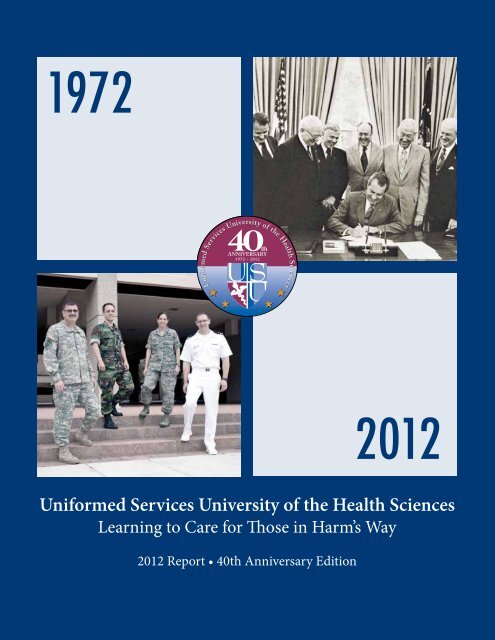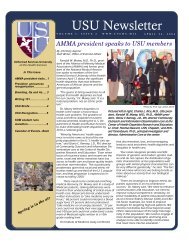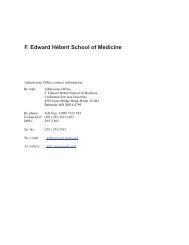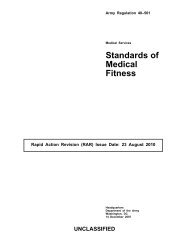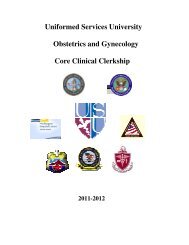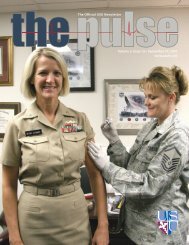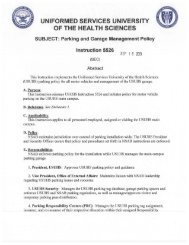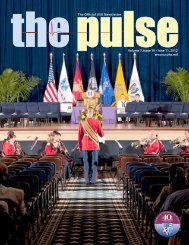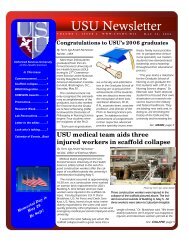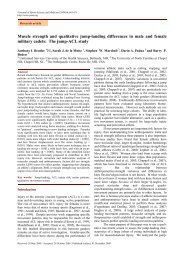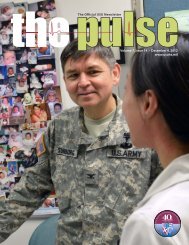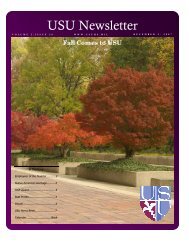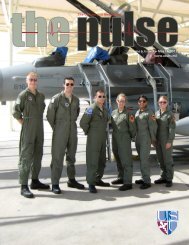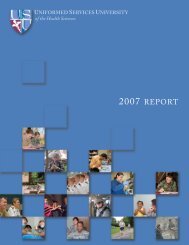2012 Annual Report - Uniformed Services University of the Health ...
2012 Annual Report - Uniformed Services University of the Health ...
2012 Annual Report - Uniformed Services University of the Health ...
You also want an ePaper? Increase the reach of your titles
YUMPU automatically turns print PDFs into web optimized ePapers that Google loves.
1972<br />
<strong>2012</strong><br />
<strong>Uniformed</strong> <strong>Services</strong> <strong>University</strong> <strong>of</strong> <strong>the</strong> <strong>Health</strong> Sciences<br />
Learning to Care for Those in Harm’s Way<br />
<strong>2012</strong> <strong>Report</strong> • 40th Anniversary Edition
<strong>2012</strong> <strong>Report</strong> • 40th Anniversary Edition<br />
USU’s Founding Legislation<br />
The <strong>Uniformed</strong> <strong>Services</strong> <strong>University</strong> <strong>of</strong> <strong>the</strong> <strong>Health</strong> Sciences was established by Congress<br />
in 1972 as part <strong>of</strong> <strong>the</strong> <strong>Uniformed</strong> <strong>Services</strong> <strong>Health</strong> Pr<strong>of</strong>essions Revitalization Act.<br />
The charter, signed by Speaker <strong>of</strong> <strong>the</strong> House <strong>of</strong> Representatives Carl Albert, President<br />
<strong>of</strong> Senate Pro Tempore James O. Eastland and Congressman F. Edward Hébert, was<br />
signed into law by President Richard M. Nixon on September 21, 1972.<br />
2
<strong>Uniformed</strong> <strong>Services</strong> <strong>University</strong> <strong>of</strong> <strong>the</strong> <strong>Health</strong> Sciences<br />
Table <strong>of</strong> Contents<br />
Message from <strong>the</strong> President 4<br />
Leadership 5<br />
A Global <strong>University</strong> 6<br />
Board <strong>of</strong> Regents 7<br />
The Faculty Senate 8<br />
A Military-Unique Curriculum 9-11<br />
Curriculum Reform 12<br />
Expanding <strong>the</strong> Curriculum 13<br />
An Evolving Curriculum 14<br />
Leadership Legends 15<br />
USU’s Newest College 16<br />
Advancing Graduate Education 17<br />
Leading Scientific Growth 18-21<br />
National Capital Area<br />
Medical Simulation Center<br />
22<br />
Center for Neuroscience<br />
and Regenerative Medicine<br />
23<br />
Advancing <strong>the</strong> Rehabilitation<br />
<strong>of</strong> Wounded Warriors<br />
24<br />
John P. Murtha Comprehensive Cancer Center 25<br />
Building <strong>the</strong> Next Generation <strong>of</strong> Leaders 26<br />
Cover Captions. Photo One: President Richard Nixon signed <strong>the</strong> charter that created USU in 1972. Photo Two: USU has Schools <strong>of</strong> Medicine and Graduate Nursing as well as<br />
Graduate Programs in <strong>the</strong> Biomedical Sciences and a Postgraduate Dental College. Most students in <strong>the</strong>se programs are commissioned <strong>of</strong>ficers, including Army Major Rick Larango<br />
(Graduate School <strong>of</strong> Nursing), left, Public <strong>Health</strong> Service Ensign Jaren Meldrum (School <strong>of</strong> Medicine), Air Force Major Ka<strong>the</strong>rine Ware (Graduate Education) and Navy Lieutenant<br />
Gregory Gittleman (Postgraduate Dental College).<br />
1974<br />
Anthony R. Curreri, M.D., is sworn in as <strong>the</strong> first president <strong>of</strong> USU.<br />
3
<strong>2012</strong> <strong>Report</strong> • 40th Anniversary Edition<br />
Message From <strong>the</strong> President<br />
The <strong>Uniformed</strong> <strong>Services</strong> <strong>University</strong> <strong>of</strong><br />
<strong>the</strong> <strong>Health</strong> Sciences (USU) was created<br />
40 years ago to fill a void that existed<br />
in hospitals and clinics, on bases and<br />
battlefields, and o<strong>the</strong>r places where<br />
servicemembers needed—and deserved—<br />
specially trained physicians to care for<br />
<strong>the</strong>ir wounds.<br />
Four decades later, USU is still <strong>the</strong> only<br />
American university that teaches <strong>the</strong><br />
art and science <strong>of</strong> military medicine.<br />
Our scope, however, has broadened<br />
significantly over time. Now, we have<br />
a Graduate School <strong>of</strong> Nursing with<br />
nationally recognized programs,<br />
including a brand-new Doctor <strong>of</strong><br />
Nursing Practice degree. We also have<br />
a Postgraduate Dental College with<br />
master’s programs that reach across<br />
many disciplines <strong>of</strong> oral health.<br />
We are not content, however, to rest<br />
on our laurels. We plan to expand our<br />
already considerable research portfolio<br />
to pursue solutions to challenges<br />
faced by our men and women in<br />
uniform—from traumatic brain injury<br />
to emerging infectious diseases, from<br />
radiation injury to psychological health,<br />
from basic mechanisms <strong>of</strong> cellular<br />
injury to new approaches for cancer<br />
diagnosis and treatment.<br />
We continue to recruit rising young<br />
scientists to work with our already<br />
talent-laden faculty to carry out our<br />
missions in <strong>the</strong> classroom, laboratory<br />
and bedside. At USU, we want <strong>the</strong> very<br />
best for America’s troops. That was <strong>the</strong><br />
fundamental reason for establishing <strong>the</strong><br />
<strong>University</strong> and it is <strong>the</strong> key focus <strong>of</strong> <strong>the</strong><br />
celebration <strong>of</strong> our 40th anniversary.<br />
I was privileged to serve as a Navy<br />
surgeon and I am <strong>the</strong> fa<strong>the</strong>r <strong>of</strong> a Naval<br />
aviator. So making sure that <strong>the</strong> best and<br />
brightest are <strong>the</strong>re to deliver safe, reliable<br />
and effective care, anytime, anywhere,<br />
has a personal resonance for me.<br />
This publication brings some <strong>of</strong><br />
USU’s traditions and its promise to<br />
<strong>the</strong> forefront. It is a capsule <strong>of</strong> <strong>the</strong><br />
inspiring history, incredible people and<br />
compelling mission that makes USU<br />
such a unique institution.<br />
Charles L. Rice, M.D.<br />
4<br />
1975<br />
Administrative <strong>of</strong>fices are established over Peoples Drug Store<br />
on Arlington Road in downtown Be<strong>the</strong>sda, Md.
<strong>Uniformed</strong> <strong>Services</strong> <strong>University</strong> <strong>of</strong> <strong>the</strong> <strong>Health</strong> Sciences<br />
Leadership<br />
F. Edward Hébert<br />
F. Edward Hébert, a congressman from Louisiana, spent<br />
years tirelessly lobbying for a federally run medical school<br />
or “West Point <strong>of</strong> Military Medicine,” as he called it. He<br />
reasoned that <strong>the</strong> government spent billions <strong>of</strong> dollars training<br />
military troops each year so it should also invest in a<br />
place that taught people how to care for servicemembers<br />
and <strong>the</strong>ir families.<br />
Hébert’s novel idea gained little traction on Capitol Hill<br />
at first, but he eventually won over many powerful allies,<br />
including President Richard Nixon, who signed <strong>the</strong> bill that<br />
created <strong>the</strong> <strong>Uniformed</strong> <strong>Services</strong> <strong>University</strong> <strong>of</strong> <strong>the</strong> <strong>Health</strong><br />
Sciences in 1972.<br />
Hébert was proud to be a part <strong>of</strong> USU’s early history. “When<br />
my service ends, and I look back over <strong>the</strong> milestones <strong>of</strong> my<br />
career, I want most <strong>of</strong> all to be remembered for <strong>the</strong> military<br />
medical school,” he said.<br />
In recognition <strong>of</strong> his vision and influence, USU named its<br />
School <strong>of</strong> Medicine after Hébert, <strong>the</strong> longest-serving member<br />
<strong>of</strong> <strong>the</strong> United States House <strong>of</strong> Representatives, in 1983.<br />
Charles L. Rice, M.D.<br />
The <strong>University</strong> had already established a strong<br />
reputation as <strong>the</strong> academic home <strong>of</strong> military<br />
medicine when Charles L. Rice, M.D., took <strong>the</strong><br />
leadership reins in 2005 as USU’s fifth president.<br />
Still, his goals for <strong>the</strong> <strong>University</strong> were ambitious.<br />
After his swearing in, Rice began systematically expanding<br />
USU’s catalog and research portfolio. Programs in <strong>the</strong><br />
School <strong>of</strong> Medicine and Graduate School <strong>of</strong> Nursing have<br />
grown significantly under his leadership, and so has <strong>the</strong>ir<br />
research funding. USU also entered brand-new academic<br />
territory when <strong>the</strong> Postgraduate Dental College was formed<br />
in 2010. Now, Army, Navy and Air Force master’s-level<br />
dental programs fall under USU auspices.<br />
Seven years after joining USU, Rice continues to seek<br />
ways in which USU can contribute to <strong>the</strong> strength <strong>of</strong> <strong>the</strong><br />
Military <strong>Health</strong> System (MHS). Strategic relationships with<br />
o<strong>the</strong>r federal educational institutions, such as <strong>the</strong> Navy<br />
Postgraduate School and <strong>the</strong> National Defense <strong>University</strong>, are<br />
two such affiliations. Emphasis on ensuring that <strong>the</strong> lessons<br />
learned in a decade <strong>of</strong> conflict—particularly advances in<br />
trauma care, developing strong leadership skills among<br />
MHS <strong>of</strong>ficers, and increasing diversity in <strong>the</strong> medical corps<br />
<strong>of</strong> <strong>the</strong> three military services—are also areas <strong>of</strong> his focus.<br />
1976<br />
The charter class, 32 medical students, begin <strong>the</strong>ir coursework at <strong>the</strong><br />
Armed Forces Institute <strong>of</strong> Pathology in Washington, D.C.<br />
5
<strong>2012</strong> <strong>Report</strong> • 40th Anniversary Edition<br />
A Global <strong>University</strong><br />
Although USU’s educational reach extends to many different places around<br />
<strong>the</strong> world, <strong>the</strong> Be<strong>the</strong>sda, Md., campus is home to most faculty, students and<br />
staff members. Here, <strong>the</strong>y have many valuable resouces right at <strong>the</strong>ir fingertips,<br />
including state-<strong>of</strong>-<strong>the</strong>-art classrooms, sophisticated labs and an expansive Learning<br />
Resource Center with thousands <strong>of</strong> journals, books and o<strong>the</strong>r publications.<br />
But today’s sprawling, high-tech campus represents decades <strong>of</strong> expansion and<br />
evolution. USU’s first administrators and students worked and learned in humble<br />
spaces and borrowed labs. Early leaders like Anthony Curreri, <strong>the</strong> first president,<br />
carved USU’s path from rented <strong>of</strong>fices above <strong>the</strong> Peoples Drugstore and State<br />
National Bank in downtown Be<strong>the</strong>sda. The space was too small for teaching,<br />
so students attended class three miles away at <strong>the</strong> Armed Forces Institute <strong>of</strong><br />
Pathology and Walter Reed Army Medical Center.<br />
These temporary sites could not sufficiently support USU’s rapidly growing<br />
mission for long, so <strong>the</strong> first Board <strong>of</strong> Regents organized a site-selection committee<br />
to find USU a permanent home. In <strong>the</strong> end, <strong>the</strong>y chose a 100-acre parcel <strong>of</strong> land<br />
on <strong>the</strong> grounds <strong>of</strong> <strong>the</strong> National Naval Medical Center, just a few miles from<br />
Washington, D.C., and across <strong>the</strong> street from <strong>the</strong> National Institutes <strong>of</strong> <strong>Health</strong>.<br />
Construction on Building A began right away. In fact, <strong>the</strong> charter class was able to<br />
begin <strong>the</strong>ir second year on <strong>the</strong> new flagship campus in 1978. A year later, Buildings<br />
B, C and D were approved, which greatly expanded classroom, administrative and<br />
research facilities. Building E, <strong>the</strong> newest addition occupied largely by Graduate<br />
School <strong>of</strong> Nursing faculty and staff, was constructed in 2008 to meet <strong>the</strong> needs <strong>of</strong><br />
USU’s continually growing scope.<br />
With recent supplementary missions, <strong>the</strong> <strong>University</strong> has developed a branch<br />
campus in San Antonio and has acquired necessary space <strong>of</strong>f-campus in <strong>the</strong><br />
National Capital Area. Even more space proposals are being developed both<br />
on campus and <strong>of</strong>f to cover <strong>the</strong> expanding missions.<br />
6<br />
1976<br />
Deputy Secretary <strong>of</strong> Defense David Packard is named acting president.
<strong>Uniformed</strong> <strong>Services</strong> <strong>University</strong> <strong>of</strong> <strong>the</strong> <strong>Health</strong> Sciences<br />
Board <strong>of</strong> Regents<br />
Today’s Regents<br />
Today, <strong>the</strong> Board <strong>of</strong> Regents continues meeting quarterly<br />
to discuss <strong>the</strong> <strong>University</strong>’s most pressing issues. Their<br />
guidance has shaped nearly every aspect <strong>of</strong> scholarship,<br />
research and public service at USU.<br />
Like regents before <strong>the</strong>m, <strong>the</strong> current members bring<br />
exceptional leadership and counsel to USU.<br />
Founding Advisors<br />
The members <strong>of</strong> <strong>the</strong> USU Board <strong>of</strong> Regents are a<br />
prestigious mix <strong>of</strong> <strong>the</strong> nation’s top military, scientific,<br />
Ronald Blanck, D.O.<br />
Otis Brawley, M.D.<br />
Sheila Burke, MPA<br />
Haile Debas, M.D.<br />
education, policy and business leaders. David Packard,<br />
former Deputy Secretary <strong>of</strong> Defense and co-founder <strong>of</strong> <strong>the</strong><br />
Hewlett-Packard Co., was <strong>the</strong> first chairman <strong>of</strong> <strong>the</strong> board.<br />
Ambitious from <strong>the</strong> start, he and <strong>the</strong> o<strong>the</strong>r original regents<br />
met 15 times in 18 months. They made important decisions<br />
during <strong>the</strong>se early meetings, including developing and<br />
General Ronald Griffith,<br />
USA (Ret.)<br />
Michael Johns, M.D.<br />
Kenneth Moritsugu, M.D.<br />
Gail Wilensky, Ph.D.<br />
fine-tuning a unique medical curriculum and forming a<br />
search committee to find <strong>the</strong> <strong>University</strong>’s first president,<br />
dean <strong>of</strong> <strong>the</strong> medical school and o<strong>the</strong>r academic leaders to<br />
move USU’s mission forward.<br />
Jonathan Woodson, M.D.<br />
Charles Rice, M.D.<br />
Lieutenant General<br />
Patricia Horoho, USA<br />
Vice Admiral Mat<strong>the</strong>w<br />
Nathan, USN<br />
Lieutenant General<br />
Thomas Travis, USAF<br />
Vice Admiral Regina<br />
Benjamin, USPHS<br />
1981<br />
Stephen Huot is <strong>the</strong> first student to be awarded a Ph.D. from USU.<br />
7
<strong>2012</strong> <strong>Report</strong> • 40th Anniversary Edition<br />
The Faculty Senate<br />
The first Faculty Senate was formed<br />
in 1978, one year after <strong>the</strong> charter<br />
class arrived at USU. Popular pr<strong>of</strong>essors<br />
Kathryn Holmes, Ph.D., and<br />
Harry Holloway, M.D., were both<br />
named temporary chairs until Lucy<br />
Chang, Ph.D., took over as <strong>the</strong> first<br />
permanent president <strong>of</strong> <strong>the</strong> Faculty<br />
Senate less than a year later.<br />
These leaders, with support from faculty<br />
members in each department, quickly<br />
became a powerful voice at USU. Each<br />
successive group has maintained <strong>the</strong><br />
same influence while also bringing<br />
many new traditions to USU, including<br />
Research Week, <strong>the</strong> Packard Lecture<br />
and Education Day. These annual events<br />
celebrate USU’s broad accomplishments<br />
in medicine, nursing, dentistry and<br />
biomedical science.<br />
O<strong>the</strong>r leaders travel far and wide<br />
to attend <strong>the</strong>se events, as well. In<br />
<strong>2012</strong>, esteemed surgeon Murray<br />
Brennan, M.D., delivered <strong>the</strong> Senate<br />
Packard Lecture, and nurse pathfinder<br />
Geraldine “Polly” Bednash, Ph.D., gave<br />
<strong>the</strong> keynote address at Education Day.<br />
Both were invited by <strong>the</strong> Faculty Senate<br />
to talk about today’s most pressing<br />
health care needs.<br />
“As we stand toge<strong>the</strong>r on <strong>the</strong> shifting<br />
ground that is <strong>the</strong> landscape <strong>of</strong> health<br />
care, it is critical for USU to have good<br />
communication—both upstream and<br />
downstream—between our leadership<br />
and our faculty. The Senate strives to<br />
improve those essential connections,”<br />
said James Smirniotopoulos, M.D., president<br />
<strong>of</strong> <strong>the</strong> <strong>2012</strong>-2013 Faculty Senate.<br />
8<br />
1983<br />
The Henry M. Jackson Foundation for <strong>the</strong> Advancement <strong>of</strong> Military Medicine is established by<br />
Congress to support <strong>the</strong> <strong>University</strong>’s teaching and research programs.
<strong>Uniformed</strong> <strong>Services</strong> <strong>University</strong> <strong>of</strong> <strong>the</strong> <strong>Health</strong> Sciences<br />
A Military-Unique Curriculum<br />
The <strong>University</strong>’s earliest administrators began developing a unique<br />
medical curriculum soon after <strong>the</strong> legislation to create USU was<br />
passed. A Department <strong>of</strong> Military Medicine and History was an<br />
important piece <strong>of</strong> that framework, and a novel idea. Only four<br />
American medical schools had entire history departments, and<br />
USU’s was —and still is—<strong>the</strong> only one with a military-centric focus.<br />
Army Colonel Robert J.T. Joy, a Yale<br />
and Harvard trained physician, was<br />
<strong>the</strong> first chair <strong>of</strong> <strong>the</strong> department. He<br />
was chosen by USU’s original Board <strong>of</strong><br />
Regents because <strong>of</strong> his reputation as an<br />
exceptional military physician. He also<br />
developed a strong interest in military<br />
medical history over <strong>the</strong> years, an<br />
almost nonexistent genre back <strong>the</strong>n.<br />
Joy began publishing papers on <strong>the</strong><br />
topic, which helped close <strong>the</strong> knowledge<br />
gap surrounding military medical<br />
history, and he quickly made a name<br />
for himself in various history circles.<br />
When Joy retired from <strong>the</strong> Army, he<br />
and Jay Sanford, M.D., USU’s third<br />
president, recognized <strong>the</strong> need for<br />
additional expertise, so <strong>the</strong>y recruited<br />
Dale Smith, Ph.D., a medical historian<br />
from <strong>the</strong> <strong>University</strong> <strong>of</strong> Minnesota.<br />
Toge<strong>the</strong>r, <strong>the</strong>y built an independent<br />
department with a unique curriculum<br />
from <strong>the</strong> ground up, that both<br />
researched and taught lessons about<br />
<strong>the</strong> general development <strong>of</strong> patient<br />
care, disease and society with specific<br />
lectures on <strong>the</strong> history <strong>of</strong> anatomy,<br />
physiology, microbiology, surgery<br />
and psychiatry. At <strong>the</strong> request <strong>of</strong> <strong>the</strong><br />
Army Medical Department Center and<br />
School, Joy and Smith also established<br />
a graduate program at USU in military<br />
medical history for Army Medical<br />
Service Corps <strong>of</strong>ficers.<br />
Joy and Smith, one <strong>of</strong> USU’s most<br />
dynamic partnerships, worked toge<strong>the</strong>r<br />
for more than two decades.<br />
Their lectures were favorites among<br />
<strong>the</strong> student body, and both faculty<br />
Army Colonel Robert J.T. Joy, M.D.<br />
members have been asked to speak<br />
about military medical history at<br />
universities, on television and before<br />
organizations around <strong>the</strong> world.<br />
Military medical history is still an<br />
important part <strong>of</strong> <strong>the</strong> USU program,<br />
with two newer faculty members,<br />
Drs. Kristin Heitman and Stephen Craig,<br />
taking <strong>the</strong> lead. Today, medical students<br />
must complete more than 30 hours <strong>of</strong><br />
history coursework to graduate, and<br />
Smith, now <strong>the</strong> senior vice president<br />
<strong>of</strong> USU, still delivers some <strong>of</strong> <strong>the</strong><br />
department’s most vivid lectures.<br />
Joy retired from USU in 1996, but his<br />
legacy continues to thrive with <strong>the</strong><br />
department he created and a discipline<br />
he pioneered.<br />
1987<br />
President Ronald Reagan delivers <strong>the</strong> commencement address to USU’s graduating class.<br />
9
<strong>2012</strong> <strong>Report</strong> • 40th Anniversary Edition<br />
A Military-Unique Curriculum<br />
The Department <strong>of</strong> Military and Emergency Medicine is<br />
unique among <strong>the</strong> nation’s 138 medical schools. Its innovative<br />
curriculum is designed to develop students’ expertise<br />
in clinical medicine as well as operational medicine and<br />
military medical leadership, and includes lessons based on<br />
real-life experiences in deployed and combat settings.<br />
Field exercises have always been one <strong>of</strong> <strong>the</strong> most dynamic<br />
pieces <strong>of</strong> <strong>the</strong> curriculum. During this important training,<br />
students learn about military medicine on both real and<br />
simulated battlefields, and in austere environments, <strong>of</strong>ten<br />
under challenging conditions.<br />
The first exercise is a seven-mile march across <strong>the</strong> Antietam<br />
National Battlefield, home to <strong>the</strong> bloodiest single-day<br />
fight in American history. Here, students receive a lesson on<br />
how Civil War medicine influenced modern military triage,<br />
especially <strong>the</strong> casualty management and evacuation system<br />
developed by Army surgeon Jonathan Letterman. A variation<br />
<strong>of</strong> <strong>the</strong>se life-saving methods is still used by military doctors<br />
and nurses in deployment zones around <strong>the</strong> world today.<br />
10<br />
1993<br />
More than 100 USU alumni serve in Operations Desert Shield and Desert Storm.
<strong>Uniformed</strong> <strong>Services</strong> <strong>University</strong> <strong>of</strong> <strong>the</strong> <strong>Health</strong> Sciences<br />
A Military-Unique Curriculum<br />
FTX 101, formerly called Operation Kerkesner, is <strong>the</strong> firstyear<br />
medical student exercise. It takes place at a military<br />
training base in Pennsylvania and closely replicates actual<br />
field conditions. Students learn important military skills like<br />
hand-to-hand combat, search-and-rescue tactics, small squad<br />
movement, combat casualty care and basic field medical skills.<br />
Jay P. Sanford, M.D.<br />
Jay P. Sanford, M.D., <strong>the</strong> <strong>University</strong>’s third president, was<br />
a hands-on leader with an adventurous side. Not only<br />
did Sanford teach courses and make hospital rounds<br />
regularly, he also rappelled down <strong>the</strong> sides <strong>of</strong> university<br />
buildings, parachuted from airplanes and completed field<br />
training with students at USU.<br />
Sanford, who was also dean <strong>of</strong> <strong>the</strong> medical school for<br />
15 years, was formally recognized by USU for his many<br />
contributions: <strong>the</strong> <strong>University</strong>’s largest lecture hall was<br />
named <strong>the</strong> Jay P. Sanford Auditorium in honor <strong>of</strong> <strong>the</strong><br />
legendary president.<br />
Operation Bushmaster is <strong>the</strong> last field exercise before graduation.<br />
The five-day final examination also takes place in<br />
Pennsylvania and replicates a combat environment, complete<br />
with different echelons <strong>of</strong> care and simulated injuries, which<br />
include chemical burns, impalements, gunshot wounds and<br />
harder to identify injuries like concussions and traumatic<br />
brain injuries. Students must diagnose and treat <strong>the</strong>se wounds<br />
while also leading multidisciplinary medical teams in <strong>the</strong> field<br />
or at <strong>the</strong> forward operating bases <strong>the</strong>y helped build. They also<br />
face ethical, moral and command decisions.<br />
Today, Sanford Hall is used for education, distinguished<br />
guest lectures and o<strong>the</strong>r academic events Sanford helped<br />
establish throughout his tenure at USU.<br />
1995<br />
USU welcomes its first second-generation student, Navy Ensign Nathaniel Almond.<br />
His fa<strong>the</strong>r, Navy Captain Myron Almond, is a 1981 alumnus.<br />
11
<strong>2012</strong> <strong>Report</strong> • 40th Anniversary Edition<br />
Curriculum Reform<br />
Landmark reports over <strong>the</strong> past<br />
century have influenced change and<br />
evolution in medical education. The<br />
<strong>University</strong> has recently embraced this<br />
education reform.<br />
After two years <strong>of</strong> detailed planning,<br />
USU rolled out a brand-new<br />
curriculum called “Molecules to<br />
Military Medicine” in August 2011.<br />
The completely overhauled program<br />
maintains USU’s signature military<br />
footprint and provides a much<br />
stronger link between classroom<br />
learning and clinical experience.<br />
Now, students begin interacting<br />
with patients much sooner. In fact,<br />
<strong>the</strong>y start learning how to conduct<br />
a medical interview and orchestrate<br />
a complete, head-to-toe physical<br />
examination during <strong>the</strong> first week <strong>of</strong><br />
medical school. These activities, once<br />
reserved for more advanced students,<br />
help contextualize basic science in a<br />
more meaningful and personal way.<br />
But earlier hands-on learning<br />
is just one <strong>of</strong> several large-scale<br />
transformations in <strong>the</strong> revised<br />
curriculum. Older, discipline-based<br />
courses have been replaced by<br />
integrated modules that combine<br />
key concepts from different subject<br />
areas into more comprehensive units<br />
based on various organ systems.<br />
Coursework about <strong>the</strong> cardiovascular<br />
and renal systems, for example,<br />
includes benchmarks from several<br />
different fields in one streamlined,<br />
nine-week module.<br />
This method, combined with advanced<br />
clinical training and state-<strong>of</strong>-<strong>the</strong>-art<br />
simulation education, helps students<br />
assimilate <strong>the</strong> science <strong>of</strong> medicine into<br />
everyday practice. It also gives <strong>the</strong>m a<br />
more complete experience, starting <strong>the</strong><br />
moment <strong>the</strong>y step foot on campus.<br />
“The expertise and teamwork <strong>of</strong> an<br />
exceptionally dedicated faculty and<br />
staff has allowed USU to accomplish<br />
in two years what has taken most U.S.<br />
medical schools three to seven years<br />
to achieve,” said Air Force Colonel<br />
Arnyce Pock, M.D., director <strong>of</strong> <strong>the</strong><br />
Office <strong>of</strong> Curriculum Reform. “Our<br />
medical students are responding very<br />
positively to <strong>the</strong> new curriculum. It<br />
significantly enhances <strong>the</strong>ir learning<br />
experience.”<br />
12<br />
1999<br />
The Center for Disaster and Humanitarian Assistance Medicine is established at USU.
<strong>Uniformed</strong> <strong>Services</strong> <strong>University</strong> <strong>of</strong> <strong>the</strong> <strong>Health</strong> Sciences<br />
Expanding <strong>the</strong> Curriculum<br />
James Zimble, M.D.<br />
James Zimble, M.D., USU’s fourth<br />
president, was a popular leader with<br />
an impressive military record. Before<br />
coming to USU, he oversaw <strong>the</strong> development<br />
<strong>of</strong> an integrated worldwide<br />
master plan for military medicine.<br />
Afterward, Zimble was promoted to<br />
vice admiral and appointed Surgeon<br />
General <strong>of</strong> <strong>the</strong> Navy.<br />
Zimble retired from <strong>the</strong> military after<br />
his four-year term in Washington,<br />
D.C., ended. He came to USU soon<br />
after, where he continued transforming<br />
military medicine though scholarship<br />
and research. Zimble also helped<br />
push USU’s boundaries into brandnew<br />
academic disciplines. Under his<br />
leadership, <strong>the</strong> Graduate School <strong>of</strong><br />
Nursing was created at USU.<br />
In USU’s medical and nursing schools,<br />
Zimble was known for his effective<br />
leadership and friendly manner. He<br />
took time out <strong>of</strong> every workday to<br />
visit with all levels <strong>of</strong> personnel. He<br />
also delivered impromptu lessons<br />
about life as a military physician<br />
that for him included experience in<br />
undersea medicine, several deployments,<br />
program development and<br />
countless leadership roles at bases<br />
around <strong>the</strong> world.<br />
In <strong>the</strong> fall <strong>of</strong> 1992, Congress mandated<br />
<strong>the</strong> establishment <strong>of</strong> a nurse practitioner<br />
program at USU. Soon after, a charter<br />
class <strong>of</strong> three students set <strong>the</strong> precedent<br />
for <strong>the</strong> new school.<br />
The intent <strong>of</strong> <strong>the</strong> legislation was to<br />
meet <strong>the</strong> increasing needs for advanced<br />
practice nurses in <strong>the</strong> uniformed services.<br />
A task force was established to assist with<br />
program development, which included<br />
faculty members from both <strong>the</strong> School<br />
<strong>of</strong> Medicine, graduate programs and<br />
representatives from <strong>the</strong> <strong>Services</strong>.<br />
“While we’re known for our medical<br />
school, our stated mission is to provide<br />
<strong>the</strong> nation with health pr<strong>of</strong>essionals<br />
dedicated to career service in <strong>the</strong><br />
military and U.S. Public <strong>Health</strong> Service,”<br />
said James Zimble, M.D., president<br />
<strong>of</strong> USU when <strong>the</strong> Graduate School <strong>of</strong><br />
Nursing (GSN) was created. “This new<br />
program expands <strong>the</strong> reach <strong>of</strong> USU in<br />
supplying nurses with advanced skills and<br />
dedication to public service.”<br />
Two years later, students from USU’s newly<br />
created Nurse Anes<strong>the</strong>tist program arrived<br />
on campus. A year after <strong>the</strong>y graduated,<br />
two new tracks were added, a Perioperative<br />
Clinical Nurse Specialist program and a<br />
Doctor <strong>of</strong> Philosophy in Nursing Science,<br />
followed by <strong>the</strong> Adult Psychiatric Mental<br />
<strong>Health</strong> Practitioner program in 2008.<br />
These five programs complete GSN<br />
scholarship opportunities at USU today.<br />
However, many <strong>of</strong> <strong>the</strong> master’s tracks<br />
have grown into Doctor <strong>of</strong> Nursing<br />
Practice degrees—an evolution that<br />
fur<strong>the</strong>r leverages USU’s important role in<br />
military health care. It also demonstrates<br />
how visionary thinking can expand a<br />
school into something much bigger and<br />
broader with enough diverse expertise<br />
to care for servicemembers and <strong>the</strong>ir<br />
families in many different environments.<br />
2000<br />
White House physician and Naval <strong>of</strong>ficer Eleanor Connie Mariano<br />
is <strong>the</strong> first USU alumnus to reach flag rank.<br />
13
<strong>2012</strong> <strong>Report</strong> • 40th Anniversary Edition<br />
An Evolving Curriculum<br />
The <strong>University</strong>’s nursing graduates have taken on extraordinary<br />
roles at duty stations around <strong>the</strong> globe for nearly two decades<br />
now. They have knowledge that is not taught at civilian universities<br />
and harness unique skills when caring for patients in<br />
challenging situations or in state-<strong>of</strong>-<strong>the</strong>-art military treatment<br />
facilities. The decisions <strong>the</strong>y make on battlefields, ravaged<br />
lands and hospitals closer to home can save a life or hundreds<br />
at once, because <strong>the</strong> GSN has always been focused on <strong>the</strong><br />
needs <strong>of</strong> patients in peace and war, at all echelons <strong>of</strong> care.<br />
This formula is guiding innovation in <strong>the</strong> GSN. A recent<br />
curriculum evolution builds on <strong>the</strong> traditional master’s<br />
programs and provides graduates with additional skills and<br />
education for <strong>the</strong> 21st century.<br />
In <strong>2012</strong>, <strong>the</strong> first class <strong>of</strong> Doctor <strong>of</strong> Nursing Practice (DNP)<br />
students matriculated, and <strong>the</strong> program is already pushing<br />
students to new heights.<br />
“Graduates will be prepared as advanced practice nurses<br />
and also receive advanced education in health policy, health<br />
economics, informatics, population health and systems<br />
leadership,” said Carol Romano, Ph.D., associate dean for<br />
Academic Affairs in <strong>the</strong> GSN. “The DNP curriculum is<br />
designed so <strong>the</strong> graduates are poised to improve entire systems<br />
<strong>of</strong> care and patient outcomes for America’s fighting force.”<br />
Like all USU programs, <strong>the</strong> DNP is rigorous. Students must<br />
use critical thinking for assignments that demonstrate<br />
<strong>the</strong>ir ability to use evidence-based practice, make quality<br />
improvements and lead multidisciplinary health care<br />
teams effectively. Before graduation, students must also<br />
complete a final scholarly inquiry project, that demonstrates<br />
<strong>the</strong>ir aptitude for positively transforming health care in<br />
meaningful ways.<br />
“The clinical doctorate is becoming a standard for<br />
advanced nursing practice preparation and <strong>the</strong> Graduate<br />
School <strong>of</strong> Nursing is on <strong>the</strong> forefront <strong>of</strong> implementing this<br />
standard,” Romano said. “Our alumni will be positioned to<br />
lead and facilitate translation <strong>of</strong> <strong>the</strong> best science in federal<br />
health care systems for our warriors and <strong>the</strong>ir families<br />
today and tomorrow.”<br />
14<br />
2001<br />
USU alumni and faculty play key medical response roles in <strong>the</strong> aftermath<br />
<strong>of</strong> <strong>the</strong> terrorist attacks on Sept. 11.
<strong>Uniformed</strong> <strong>Services</strong> <strong>University</strong> <strong>of</strong> <strong>the</strong> <strong>Health</strong> Sciences<br />
Leadership Legends<br />
Faye Abdellah<br />
Ada Sue Hinshaw<br />
Faye Abdellah, Ed.D., was already a legend in <strong>the</strong> nursing world<br />
by <strong>the</strong> time she joined USU’s faculty in 1993. A 40-year Public<br />
<strong>Health</strong> Service veteran, Abdellah was <strong>the</strong> first nurse to become<br />
a rear admiral and <strong>the</strong> Deputy Surgeon General <strong>of</strong> <strong>the</strong> United<br />
States. Her rise came on <strong>the</strong> heels <strong>of</strong> many groundbreaking<br />
accomplishments, including changing <strong>the</strong> way nursing <strong>the</strong>ory is<br />
taught and practiced at universities and hospitals across <strong>the</strong><br />
nation. Abdellah also developed <strong>the</strong> first federally tested coronary<br />
care unit and has authored many books that are still considered<br />
gold standards for education, including her seminal publication,<br />
“Patient Centered Approaches to Nursing.” In June <strong>2012</strong>, she was<br />
inducted into <strong>the</strong> American Nurses Association Hall <strong>of</strong> Fame.<br />
Abdellah’s impressive resume caught <strong>the</strong> attention <strong>of</strong> USU’s<br />
leadership, who wanted to reach into new areas <strong>of</strong> scholarship.<br />
As a result, she was asked to chair a task force that studied <strong>the</strong><br />
benefits <strong>of</strong> establishing a nursing school at USU in 1990.<br />
Her recommendation—to create graduate programs that<br />
would prepare advanced practice nurses for leadership roles<br />
in <strong>the</strong> military—was heeded when USU’s Graduate School <strong>of</strong><br />
Nursing was established in 1993. She was appointed dean soon<br />
after and quickly began implementing signature curriculums<br />
for <strong>the</strong> first classes <strong>of</strong> Family Nurse Practitioner and Nurse<br />
Anes<strong>the</strong>sia students.<br />
Ada Sue Hinshaw, Ph.D., dean <strong>of</strong> USU’s Graduate School <strong>of</strong><br />
Nursing, has been moving nursing boundaries for several<br />
decades now. Over <strong>the</strong> course <strong>of</strong> her impressive career, Hinshaw’s<br />
research has led to newer, better standards <strong>of</strong> patient safety and<br />
care at hospitals across <strong>the</strong> nation. Fur<strong>the</strong>rmore, her leadership<br />
has transformed higher education for nurses, especially at USU,<br />
where she is overseeing a large-scale curriculum evolution that<br />
is taking master’s-level programs and turning <strong>the</strong>m into more<br />
advanced Doctor <strong>of</strong> Nursing Practice degrees.<br />
Hinshaw’s work at USU combined with several additional trailblazing<br />
accomplishments, including serving as <strong>the</strong> first director<br />
<strong>of</strong> <strong>the</strong> National Institute for Nursing Research at <strong>the</strong> National<br />
Institutes <strong>of</strong> <strong>Health</strong>, have been recognized by nearly every<br />
pr<strong>of</strong>essional nursing organization in <strong>the</strong> United States.<br />
In 2011 alone, she was named a “Living Legend” by <strong>the</strong> American<br />
Academy <strong>of</strong> Nursing and received <strong>the</strong> Pioneering Spirit<br />
Award from <strong>the</strong> American Association <strong>of</strong> Critical Care Nurses.<br />
“Receiving awards from my peers is always a tremendous honor.<br />
But for me, <strong>the</strong> most satisfying part <strong>of</strong> my work is knowing I’m<br />
making a difference in <strong>the</strong> health care <strong>of</strong> people,” Hinshaw said.<br />
“At USU, I’m helping o<strong>the</strong>rs do <strong>the</strong> same, and I can’t imagine<br />
anything more rewarding than that.”<br />
2002<br />
The Center for <strong>Health</strong> Disparities is established at USU.<br />
15
<strong>2012</strong> <strong>Report</strong> • 40th Anniversary Edition<br />
USU’s Newest College<br />
Military dentistry has many rewards, but<br />
nothing beats a warrior’s smile, say all<br />
three deans <strong>of</strong> <strong>the</strong> Postgraduate Dental<br />
College (PDC), <strong>the</strong> newest large-scale<br />
academic expansion at USU that includes<br />
Army, Navy and Air Force schools.<br />
The vision for a postgraduate dental<br />
college began in 2007 when <strong>the</strong>n-Assistant<br />
Surgeon General <strong>of</strong> <strong>the</strong> Air Force<br />
and Chief <strong>of</strong> Dental <strong>Services</strong> Major<br />
General Gar Graham asked USU’s<br />
President Charles L. Rice to explore <strong>the</strong><br />
idea. After much discussion, <strong>the</strong> Board<br />
<strong>of</strong> Regents recommended <strong>the</strong> establishment<br />
<strong>of</strong> service-specific postgraduate<br />
dental schools, all aligned under <strong>the</strong> USU<br />
Postgraduate Dental College. The Middle<br />
States Commission on Higher Education,<br />
USU’s accreditation authority, granted<br />
<strong>the</strong> substantial change request in February<br />
2010 and <strong>the</strong> first class <strong>of</strong> Naval and<br />
Air Force students matriculated in July<br />
2010. Since <strong>the</strong>n, <strong>the</strong> Army Postgraduate<br />
Dental School has been added. Retired<br />
Army Major General Patrick Sculley was<br />
appointed as interim Executive Dean <strong>of</strong><br />
<strong>the</strong> College in 2010 and Executive Dean<br />
<strong>the</strong> following year.<br />
In June <strong>2012</strong>, <strong>the</strong> PDC graduated its first<br />
class, consisting <strong>of</strong> 28 postgraduate dental<br />
residents from <strong>the</strong> Air Force and Navy<br />
programs. The College has now grown<br />
to include seven specialties spread over<br />
Army Colonel<br />
Robert Manga<br />
five locations and includes 132 faculty<br />
and 123 students with fur<strong>the</strong>r expansions<br />
planned, including <strong>the</strong> Comprehensive<br />
Dentistry program at Keesler Air Force<br />
Base in summer 2013.<br />
The deans <strong>of</strong> <strong>the</strong>se dental schools—<br />
Army Colonel Robert Manga, Navy<br />
Captain Glenn Munro and Air Force<br />
Colonel Thomas Schneid—have brought<br />
a new kind <strong>of</strong> wisdom and experience to<br />
<strong>the</strong> <strong>University</strong>.<br />
“Comprehensive dentists have special<br />
training that expands <strong>the</strong>ir scope <strong>of</strong><br />
general practice,” Munro said. “Our<br />
versatility is really important, especially<br />
in operational settings, because <strong>the</strong><br />
military can’t afford to lose anyone on<br />
<strong>the</strong> front lines.”<br />
“Our residencies are world class,” Schneid<br />
said. “They have strong didactic and<br />
clinical components as well as robust<br />
research programs.”<br />
Navy Captain<br />
Glenn Munro<br />
Air Force Colonel<br />
Thomas Schneid<br />
“My job is wonderful, because I help<br />
soldiers feel better. Restoring a person’s<br />
smile is a priceless feeling. I can’t<br />
imagine doing anything else,” Manga<br />
said. “Soldiers make incredible sacrifices<br />
to serve <strong>the</strong> greater good. Taking care <strong>of</strong><br />
<strong>the</strong>m is truly an honor.”<br />
“I am very proud <strong>of</strong> <strong>the</strong> accomplishments<br />
<strong>of</strong> <strong>the</strong> students and faculty <strong>of</strong><br />
USU’s newest college,” Sculley said.<br />
“They are magnificent representatives <strong>of</strong><br />
<strong>the</strong> excellence that is <strong>the</strong> <strong>University</strong>.”<br />
Retired Army Major General<br />
Patrick Sculley<br />
16<br />
2003<br />
U.S. News & World <strong>Report</strong> ranks USU’s community health program as sixth in <strong>the</strong> nation.
<strong>Uniformed</strong> <strong>Services</strong> <strong>University</strong> <strong>of</strong> <strong>the</strong> <strong>Health</strong> Sciences<br />
Advancing<br />
Graduate Education<br />
Air Force Second Lieutenant<br />
John Trentini<br />
Every academic program at USU is<br />
demanding and time intensive. Still,<br />
Air Force Second Lieutenant John<br />
Trentini is pursuing two degrees at<br />
once. He’s part <strong>of</strong> USU’s combined<br />
M.D./Ph.D. program, a track so<br />
rigorous only three o<strong>the</strong>r people<br />
have completed it.<br />
Trentini began <strong>the</strong> program in 2006,<br />
and if everything goes according to<br />
plan, he will graduate in 2013 as both<br />
a physician and a neuroscientist.<br />
Trentini believes <strong>the</strong>se complementary<br />
fields will inform both his medical<br />
practice and future research pursuits.<br />
“I’ve learned to think about medicine<br />
and science in two totally different<br />
ways. Through my Ph.D. coursework,<br />
I was encouraged to look at complex<br />
medical problems and discover novel<br />
explanations and treatment strategies,”<br />
he said. “I feel that my scientific<br />
curiosity is a great asset to patient care<br />
in that I will always pursue <strong>the</strong> most<br />
current <strong>the</strong>rapeutic strategies.”<br />
Graduate programs are an essential<br />
element <strong>of</strong> every medical school. In<br />
fact, <strong>the</strong>y were part <strong>of</strong> <strong>the</strong> founding<br />
USU legislation, but Randall Holmes,<br />
M.D., Ph.D., a pioneer for early<br />
doctoral programs, helped bring real<br />
form to <strong>the</strong>m.<br />
Holmes authored <strong>the</strong> founding<br />
document that later established USU’s<br />
rigorous graduate degree requirements.<br />
Soon after, all <strong>of</strong> USU’s basic science<br />
departments used his framework to<br />
begin organizing doctoral programs.<br />
Pharmacology and Physiology were<br />
<strong>the</strong> first departments at USU to create<br />
graduate programs with qualifying<br />
examinations and <strong>the</strong>sis defense<br />
compositions in 1977, requirements<br />
mandated by <strong>the</strong> Holmes document.<br />
USU’s o<strong>the</strong>r departments began<br />
systematically organizing <strong>the</strong>ir<br />
own graduate programs, too.<br />
John Bullard, Ph.D., ano<strong>the</strong>r<br />
early trailblazer in USU’s School<br />
<strong>of</strong> Medicine, oversaw much <strong>of</strong><br />
this growth as <strong>the</strong> first assistant<br />
dean for Graduate Education<br />
and associate dean for Continuing<br />
Education.<br />
Bullard, recognizing <strong>the</strong><br />
importance <strong>of</strong> robust graduate<br />
education opportunities, helped<br />
organize a colloquium to showcase<br />
USU’s growing research portfolio.<br />
Over <strong>the</strong> years, it has developed into<br />
an annual event with presentations and<br />
distinguished guest speakers from <strong>the</strong><br />
nation’s leading universities and scientific<br />
institutions.<br />
The <strong>University</strong> formally recognized<br />
Bullard’s many contributions in 1990,<br />
shortly after his retirement and just as<br />
USU’s first interdisciplinary programs<br />
were being formed, by naming <strong>the</strong><br />
colloquium’s keynote lecture after him.<br />
Today, <strong>the</strong> event continues drawing<br />
bright minds in science, including<br />
Nora Volkow, M.D., director <strong>of</strong> <strong>the</strong><br />
National Institute <strong>of</strong> Drug Abuse at<br />
<strong>the</strong> National Institutes <strong>of</strong> <strong>Health</strong>, who<br />
presented <strong>the</strong> <strong>2012</strong> Bullard Lecture.<br />
John W. Bullard, Ph.D.<br />
IDCRP<br />
2005<br />
The Infectious Disease Clinical Research Program is established at USU.<br />
17
<strong>2012</strong> <strong>Report</strong> • 40th Anniversary Edition<br />
Leading Scientific Growth<br />
Over <strong>the</strong> decades, numerous research<br />
labs at USU have been pioneers in<br />
cutting-edge research developments.<br />
One <strong>of</strong> those such labs is directed by<br />
Dr. Alison O’Brien.<br />
Alison O’Brien, Ph.D., pr<strong>of</strong>essor and<br />
chair <strong>of</strong> <strong>the</strong> Department <strong>of</strong> Microbiology<br />
and Immunology, has been leading<br />
scientific growth at USU for 34 years<br />
now. She arrived on campus soon after<br />
<strong>the</strong> first permanent buildings were<br />
completed in 1978 and has been pursuing<br />
research aimed at understanding <strong>the</strong><br />
roles <strong>of</strong> Shiga toxins in <strong>the</strong> pathogenesis<br />
<strong>of</strong> E. coli infections ever since.<br />
Her lab has yielded many significant<br />
breakthroughs over <strong>the</strong> past three<br />
decades, including discovering <strong>the</strong><br />
toxins produced by certain emerging<br />
pathogenic E. coli were <strong>the</strong> same as<br />
Shiga toxin produced by Shigella. Her<br />
laboratory also showed that multiple<br />
types <strong>of</strong> Shiga toxin are made by E.<br />
coli. Fur<strong>the</strong>rmore, her team was first to<br />
produce monoclonal antibodies that<br />
neutralize <strong>the</strong> different Shiga toxin types.<br />
These early discoveries catalyzed many<br />
new investigations. Since <strong>the</strong>n, O’Brien<br />
has developed humanized antibodies<br />
for diagnosing, treating and preventing<br />
diseases caused by E. coli. She has<br />
several patents for this work, which have<br />
been licensed to major biotechnology<br />
companies with worldwide reach. Her<br />
research is also widely published in<br />
leading microbiology journals.<br />
Today, O’Brien’s lab continues investigating<br />
E. coli Shiga toxins with multiple<br />
foci on <strong>the</strong> pathogenesis <strong>of</strong> hemorrhagic<br />
colitis and hemolytic uremic syndrome,<br />
<strong>the</strong> roles <strong>of</strong> Rho-modifying cytotoxic<br />
necrotizing factor and hemolysin in <strong>the</strong><br />
pathogenesis <strong>of</strong> E. coli-mediated urinary<br />
tract infections, and <strong>the</strong> use <strong>of</strong> sporesurface<br />
antigens <strong>of</strong> Bacillus anthracis as<br />
vaccine candidates.<br />
As with many <strong>of</strong> USU’s faculty, O’Brien is<br />
also sharing her knowledge with nextgeneration<br />
scientists at USU. She has<br />
mentored dozens <strong>of</strong> graduate students and<br />
postdoctoral fellows throughout her career.<br />
“Mentorship is <strong>the</strong> chance to give back to<br />
<strong>the</strong> next generation what was so generously<br />
given to me: respect for <strong>the</strong> scientific<br />
method, <strong>the</strong> tools to be a good scientist,<br />
and encouragement to pursue <strong>the</strong> question<br />
ra<strong>the</strong>r than <strong>the</strong> technique,” O’Brien said.<br />
Alison O’Brien, Ph.D.<br />
Mark Scher, Ph.D., and<br />
John Baker, J.D.<br />
The <strong>University</strong> and <strong>the</strong> Henry<br />
M. Jackson Foundation for <strong>the</strong><br />
Advancement <strong>of</strong> Military Medicine<br />
(HJF) formed a Joint Office <strong>of</strong><br />
Technology Transfer in 2000. This<br />
partnership, led by USU general<br />
counsel John Baker, J.D., and HJF<br />
Director <strong>of</strong> Technology Transfer and<br />
Commercialization Mark Scher, Ph.D.,<br />
encourages collaboration between<br />
military and civilian medicine to<br />
move innovative technologies into <strong>the</strong><br />
marketplace from “bench to bedside.”<br />
The <strong>of</strong>fice has successfully entered into<br />
license agreements for many products,<br />
including diagnostics for infections<br />
and vaccines for diseases, all with<br />
potential for worldwide use.<br />
18<br />
2006<br />
The Center for Deployment Psychology is established at USU.
<strong>Uniformed</strong> <strong>Services</strong> <strong>University</strong> <strong>of</strong> <strong>the</strong> <strong>Health</strong> Sciences<br />
Leading Scientific Growth<br />
<strong>University</strong> scientists have discovered<br />
a new way to render a microbe<br />
non-infectious while preserving its<br />
immune system-boosting properties<br />
after exposure to gamma radiation.<br />
The discovery could have pr<strong>of</strong>ound<br />
implications for <strong>the</strong> development<br />
<strong>of</strong> vaccines for deadly diseases like<br />
human immunodeficiency virus (HIV),<br />
explained USU Pathology Pr<strong>of</strong>essor<br />
Michael Daly, Ph.D., whose research<br />
team led <strong>the</strong> study.<br />
Daly has devoted more than 20 years<br />
to studying Deinococcus radiodurans, a<br />
microorganism that can withstand several<br />
thousand times <strong>the</strong> radiation levels that<br />
would kill a human being, and can be<br />
found nearly anywhere from your kitchen<br />
counter to <strong>the</strong> middle <strong>of</strong> a desert.<br />
Deinococcus survives <strong>the</strong>se extreme<br />
environments by accumulating high<br />
concentrations <strong>of</strong> manganese, a metal<br />
element similar to iron and peptides,<br />
which protect its proteins from destruction<br />
when exposed to high levels <strong>of</strong><br />
radiation or extremely dry conditions.<br />
Vaccines are usually made up <strong>of</strong> “bits<br />
and pieces” (epitopes) <strong>of</strong> disease-causing<br />
viruses or bacteria, he explained. When<br />
injected into a human or animal, <strong>the</strong>se<br />
provoke an immune response that<br />
includes <strong>the</strong> production <strong>of</strong> antibodies,<br />
which can defend against future infection.<br />
“However,” Daly explained, “<strong>the</strong> ‘bits and<br />
pieces’ sometimes aren’t enough, and<br />
vaccines against many deadly diseases<br />
haven’t worked.” He added that live vaccines<br />
using a weakened version <strong>of</strong> an intact virus<br />
or bacterium are most effective, but not<br />
an option when it comes to an o<strong>the</strong>rwise<br />
untreatable disease like HIV, because <strong>the</strong>y<br />
carry an unacceptable risk <strong>of</strong> infection.<br />
Radiation renders a virus or bacterium<br />
non-infectious by destroying <strong>the</strong> organism’s<br />
genetic material, but can also damage<br />
its protein structures, which <strong>the</strong> immune<br />
system needs to recognize for a vaccine<br />
to be effective. Daly’s team was able to<br />
get around this problem by isolating <strong>the</strong><br />
manganese complex from Deinococcus and<br />
using it to protect a different bacterium’s<br />
proteins from destruction by radiation.<br />
But all <strong>the</strong> proteins and all <strong>the</strong> structures<br />
on <strong>the</strong>ir surfaces remain, so you <strong>the</strong>n can<br />
take <strong>the</strong>se lethally radiated pathogens<br />
and use <strong>the</strong>m in making vaccines. As a<br />
result, <strong>the</strong> immune system thinks it is<br />
encountering <strong>the</strong> real bugs, which are<br />
now just lifeless shells, and mounts a full<br />
protective response.<br />
USU researchers, led by Daly, teamed<br />
up with scientists from <strong>the</strong> National<br />
Institutes <strong>of</strong> <strong>Health</strong> to test a vaccine for<br />
drug-resistant Staphylococcus aureus<br />
bacteria in mice. It worked. The breakthrough<br />
study was published in <strong>the</strong> July<br />
<strong>2012</strong> edition <strong>of</strong> <strong>the</strong> scientific journal, Cell<br />
Host and Microbe. Daly said it could take<br />
years to get approval for human trials,<br />
but he is optimistic this discovery will be<br />
a big help in fighting deadly diseases like<br />
HIV and influenza.<br />
“This could speed up <strong>the</strong> whole process <strong>of</strong><br />
producing vaccines. Instead <strong>of</strong> biochemists<br />
spending years trying to clone one<br />
aspect <strong>of</strong> a microbe’s protein structure,<br />
it could take only a matter <strong>of</strong> weeks to<br />
radiate all <strong>the</strong> different strains <strong>of</strong> a disease<br />
and create one vaccine to protect against<br />
all <strong>of</strong> <strong>the</strong>m,” Daly said. “We’ve shown this<br />
approach can work on Staphylococcus,<br />
which kills about 18,000 people per year.<br />
Now it’s only a matter <strong>of</strong> time before we<br />
can apply it to o<strong>the</strong>r bugs.”<br />
2008<br />
The National Center for Disaster Medicine and Public <strong>Health</strong> is established.<br />
19
<strong>2012</strong> <strong>Report</strong> • 40th Anniversary Edition<br />
Leading Scientific Growth<br />
Forty years ago, <strong>the</strong> world watched<br />
in nervous anticipation as <strong>the</strong> United<br />
States and <strong>the</strong> Soviet Union stood on<br />
<strong>the</strong> brink <strong>of</strong> nuclear war following<br />
Soviet buildup <strong>of</strong> nuclear missiles <strong>of</strong>f<br />
<strong>the</strong> coast <strong>of</strong> Cuba.<br />
Long after <strong>the</strong> end <strong>of</strong> <strong>the</strong> Cold War,<br />
<strong>the</strong> threat <strong>of</strong> possible nuclear weapons<br />
use still exists, with more than 20<br />
countries identified as possessing <strong>the</strong><br />
capability, along with <strong>the</strong> fear that<br />
various terrorist groups have access to<br />
nuclear weapons.<br />
As a result, scientists at <strong>the</strong> Armed Forces<br />
Radiobiology Research Institute (AFRRI)<br />
continued developing drugs to enhance<br />
survival <strong>of</strong> troops or civilians exposed to<br />
high doses <strong>of</strong> radiation, ei<strong>the</strong>r by accident<br />
or through terrorist activity or war.<br />
Mark Whitnall, Ph.D., a researcher at<br />
USU, was inspired by reports that an<br />
immune system-streng<strong>the</strong>ning steroid<br />
hormone called 5-androstenediol<br />
(5-AED) increased resistance to bacterial<br />
and viral infections in rodents.<br />
“Between 80 percent and 100 percent<br />
<strong>of</strong> mice treated with 5-AED survive<br />
after receiving radiation doses that are<br />
normally lethal,” Whitnall said.<br />
The hormone stimulated proliferation<br />
and differentiation <strong>of</strong> bone marrow<br />
progenitors <strong>of</strong> infection-fighting white<br />
blood cells. Elevated levels <strong>of</strong> circulating<br />
platelets were also observed, which<br />
mitigates radiation-induced hemorrhage.<br />
Fur<strong>the</strong>rmore, 5-AED exhibited very few<br />
side effects, unlike many <strong>of</strong> <strong>the</strong> o<strong>the</strong>r<br />
radioprotectants being tested during <strong>the</strong><br />
early 2000s.<br />
“The aim was to administer <strong>the</strong> drug in<br />
advance to servicemembers who run<br />
<strong>the</strong> risk <strong>of</strong> radiation exposure, with <strong>the</strong><br />
protective effects lasting a minimum <strong>of</strong><br />
one day. If troops are exposed before<br />
receiving <strong>the</strong> drug, <strong>the</strong>y could take it up<br />
to several hours after exposure, and possibly<br />
later,” Whitnall said.<br />
Today, 5-AED has been tested for<br />
safety in humans. It was found to have<br />
extremely low toxicity, and increased <strong>the</strong><br />
number <strong>of</strong> white blood cells and platelets<br />
in blood. A paper published in <strong>2012</strong> by<br />
AFRRI showed <strong>the</strong> survival-enhancing<br />
effects <strong>of</strong> 5-AED were mediated by an<br />
immune system hormone, granulocyte<br />
colony-stimulating factor. The report<br />
also showed 5-AED stimulated immune<br />
cell function and induced genes that<br />
inhibit DNA injury.<br />
Although AFRRI has continued<br />
to explore many o<strong>the</strong>r promising<br />
countermeasures against acute<br />
radiation syndrome, 5-AED was <strong>the</strong><br />
first one to obtain Investigational New<br />
Drug status from <strong>the</strong> Food and Drug<br />
Administration.<br />
“A radiation countermeasure like<br />
5-AED could save tens <strong>of</strong> thousands<br />
<strong>of</strong> people if a small nuclear device<br />
were detonated in a medium-sized<br />
city,” Whitnall said. “5-AED is <strong>the</strong><br />
prototype for a new generation <strong>of</strong> safe<br />
and effective radiation countermeasures<br />
being identified and developed at<br />
AFRRI and elsewhere.”<br />
20<br />
2009<br />
The Human Performance Resource Center is established at USU.
<strong>Uniformed</strong> <strong>Services</strong> <strong>University</strong> <strong>of</strong> <strong>the</strong> <strong>Health</strong> Sciences<br />
Leading Scientific Growth<br />
A team <strong>of</strong> USU-led scientists recently<br />
reported a major breakthrough in<br />
<strong>the</strong> development <strong>of</strong> a highly effective<br />
vaccine against <strong>the</strong> deadly Nipah virus.<br />
Nipah and Hendra viruses, found<br />
naturally in several species <strong>of</strong> Pteropid<br />
fruit bats (flying foxes), emerged in <strong>the</strong><br />
1990s causing serious disease outbreaks<br />
in humans and livestock in Australia,<br />
Bangladesh, India, Malaysia and<br />
Singapore. Recent Nipah outbreaks have<br />
resulted in acute respiratory distress<br />
syndrome and encephalitis, person-toperson<br />
transmission, and greater than<br />
75 percent case fatality rates among<br />
humans. The NIH and Centers for<br />
Disease Control and Prevention have<br />
classified Nipah and Hendra as biothreat<br />
agents, and <strong>the</strong> U.S. Department <strong>of</strong><br />
Agriculture has characterized <strong>the</strong>m as<br />
agriculture threat agents.<br />
Experiments carried out in African<br />
green monkeys demonstrated that<br />
immunizing monkeys with a vaccine<br />
based on <strong>the</strong> Hendra virus attachment<br />
G glycoprotein afforded complete<br />
protection against Nipah virus infection<br />
with no evidence <strong>of</strong> disease.<br />
“These findings are really quite<br />
promising and appear to <strong>of</strong>fer a real<br />
potential treatment for ei<strong>the</strong>r Nipah or<br />
Hendra virus infection in people,” said<br />
Christopher Broder, Ph.D., pr<strong>of</strong>essor<br />
<strong>of</strong> Microbiology at USU and <strong>the</strong> study’s<br />
corresponding author.<br />
Lead author, Katharine Bossart, Ph.D., a<br />
USU alumna and assistant pr<strong>of</strong>essor in<br />
<strong>the</strong> Department <strong>of</strong> Microbiology, Boston<br />
<strong>University</strong> School <strong>of</strong> Medicine, developed<br />
<strong>the</strong> Hendra-sG vaccine while a student<br />
in Dr. Broder’s laboratory at USU. “Since<br />
<strong>the</strong> vaccine is only a recombinant piece <strong>of</strong><br />
<strong>the</strong> virus, it can be produced by itself and<br />
purified, and is a type <strong>of</strong> vaccine known<br />
as a subunit, thus making it extremely<br />
safe to use,” Bossart said.<br />
According to study co-author Thomas<br />
Geisbert, Ph.D., a USU alumnus,<br />
“This work now provides key<br />
evidence that a simple and<br />
safe recombinant vaccine<br />
against Nipah virus is possible.<br />
Demonstrating this in a<br />
nonhuman primate model is a<br />
major step forward in developing<br />
it for future <strong>the</strong>rapeutic<br />
use in people.”<br />
“There are currently no<br />
approved vaccines for prevention<br />
<strong>of</strong> infection and disease caused<br />
by Nipah and Hendra available for use<br />
on people or livestock,” Broder said.<br />
“The vaccine had previously shown<br />
protection in ferrets against Hendra<br />
virus infection, and in cats against<br />
Nipah virus infection. In addition, <strong>the</strong><br />
Hendra-sG vaccine has been trialed in<br />
horses against Hendra virus in Australia<br />
where it has demonstrated complete<br />
protection against illness and infection.<br />
Demonstrating its potential as a<br />
safe and effective vaccine in monkeys<br />
is an important step toward being<br />
licensed for possible use in people.”<br />
2010<br />
The Postgraduate Dental College is established at USU.<br />
21
<strong>2012</strong> <strong>Report</strong> • 40th Anniversary Edition<br />
National Capital Area<br />
Medical Simulation Center<br />
Students at USU have been getting<br />
hands-on experience at <strong>the</strong> National<br />
Capital Area Medical Simulation Center<br />
for more than 12 years. The high-tech<br />
environment is used by students and<br />
faculty for many purposes, from honing<br />
surgical skills and bedside manner<br />
to practicing frontline care in field<br />
hospitals or in <strong>the</strong> trenches.<br />
This coursework, which has been a<br />
mandatory part <strong>of</strong> <strong>the</strong> Graduate School<br />
<strong>of</strong> Nursing and School <strong>of</strong> Medicine<br />
curriculums since 2000, gives students<br />
<strong>the</strong> confidence and experience <strong>the</strong>y will<br />
need for life after graduation.<br />
“The SimCenter is a place to learn from<br />
your mistakes, and simulation can provide<br />
learners with as many safe opportunities<br />
as needed,” said Gilbert Muniz, Ph.D.,<br />
deputy director <strong>of</strong> <strong>the</strong> SimCenter.<br />
Val G. Hemming, M.D.<br />
Dean <strong>of</strong> <strong>the</strong> School <strong>of</strong> Medicine, 1996-2002<br />
Medical simulations may look and feel<br />
real, but <strong>the</strong>re are no lasting consequences<br />
if things go wrong at <strong>the</strong> SimCenter. This<br />
kind <strong>of</strong> risk-free learning is one <strong>of</strong> <strong>the</strong><br />
major benefits <strong>of</strong> simulation education,<br />
which is a rapidly growing trend at health<br />
science universities across <strong>the</strong> nation.<br />
Still, <strong>the</strong> key to effective simulation is<br />
creating au<strong>the</strong>ntic, “real” experiences.<br />
The center <strong>of</strong>fers training in clinical skills<br />
using standardized patients to simulate<br />
specific challenges in outpatient, inpatient<br />
and critical care settings. It also <strong>of</strong>fers<br />
surgical and medical skills training in<br />
a full-scale operating/emergency room<br />
mock-up where mannequins are also<br />
used to provide highly realistic scenarios.<br />
Award-winning computer artists and<br />
programmers make up <strong>the</strong> Virtual<br />
Medical Environments (VME) Lab.<br />
These multitalented center staffers<br />
have done groundbreaking research in<br />
haptic (force feedback so <strong>the</strong> student<br />
can “feel” as well as see <strong>the</strong> patient) and<br />
visual perception designed to enhance<br />
<strong>the</strong> realism <strong>of</strong> <strong>the</strong> virtual experience.<br />
In addition to procedural skills, <strong>the</strong><br />
VME lab focus now includes surgical,<br />
emergency room and field hospital<br />
simulations as well as medical gaming<br />
and large-scale simulations designed to<br />
train medical teams in battlefield and<br />
natural-disaster scenarios.<br />
Research Gains<br />
USU received <strong>the</strong> highest ranking on<br />
The Chronicle <strong>of</strong> Higher Education’s<br />
list <strong>of</strong> colleges making <strong>the</strong> largest gain<br />
in receiving federal funds for research<br />
and development in science and<br />
engineering during a 10-year period.<br />
The report stated that federal science<br />
funds doubled at 28 colleges from<br />
1999 to 2009. USU topped <strong>the</strong> list <strong>of</strong><br />
200 colleges, with an impressive<br />
893.3 percent increase. In 1999,<br />
federal funds awarded to USU totaled<br />
$12.5 million. That amount reached<br />
$124.3 million in 2009.<br />
The SimCenter, which was dedicated<br />
in late <strong>2012</strong> as <strong>the</strong> Val G. Hemming<br />
Medical Simulation Center after <strong>the</strong><br />
former School <strong>of</strong> Medicine dean whose<br />
efforts led to its establishment, is one<br />
<strong>of</strong> <strong>the</strong> world’s most advanced centers<br />
for medical simulation education. It is<br />
currently undergoing a major renovation<br />
that will enhance <strong>the</strong> center’s<br />
technology by adding more than<br />
10,000 square feet to <strong>the</strong> floor plan and<br />
completing <strong>the</strong> Wide Area Environment,<br />
which will be used to train students in<br />
mass casualty scenarios in immersive,<br />
virtual 3-D environments.<br />
22<br />
2011<br />
Retired Navy Captain Peter Rhee leads <strong>the</strong> trauma team that saved Arizona Congresswoman<br />
Gabrielle Giffords’ life after she was shot outside a crowded Tucson grocery store.
<strong>Uniformed</strong> <strong>Services</strong> <strong>University</strong> <strong>of</strong> <strong>the</strong> <strong>Health</strong> Sciences<br />
Center for Neuroscience<br />
And Regenerative Medicine<br />
results, including <strong>the</strong> National Institutes<br />
<strong>of</strong> <strong>Health</strong>. The CNRM recently<br />
partnered with NIH to purchase a<br />
high-tech, full-body scanner with<br />
unique, cutting-edge features. The<br />
Biograph mMR takes positron emission<br />
topography and magnetic resonance<br />
imaging simultaneously, which makes<br />
patient care swifter, safer and more<br />
comprehensive, since it provides a more<br />
complete picture <strong>of</strong> metabolic activity<br />
in a shorter time frame than separate<br />
MRI and PET scans.<br />
America has been at war for more than<br />
a decade now, and thousands <strong>of</strong> servicemembers<br />
have been wounded during<br />
this time. Traumatic brain injuries,<br />
however, have been some <strong>of</strong> <strong>the</strong> most<br />
prevalent wounds <strong>of</strong> Operation Iraqi<br />
and Enduring Freedom.<br />
More than 200,000 servicemembers<br />
have been affected by TBIs worldwide.<br />
These injuries are hard to diagnose<br />
and treat. They also seem to affect each<br />
person differently, making <strong>the</strong> science<br />
to understand <strong>the</strong>m a very difficult<br />
and slow-moving field. But, <strong>the</strong> Center<br />
for Neuroscience and Regenerative<br />
Medicine (CNRM), established at USU<br />
in 2008, has taken on <strong>the</strong> challenge.<br />
Scientists from many different<br />
disciplines have joined forces at <strong>the</strong><br />
CNRM. Toge<strong>the</strong>r, <strong>the</strong>y are finding new<br />
approaches to understanding and treating<br />
TBI through biomarker identification,<br />
brain tissue neuroregeneration,<br />
rehabilitative medicine and many o<strong>the</strong>r<br />
full-spectrum research programs.<br />
The CNRM is also reaching across<br />
campus boundaries and forming<br />
partnerships with o<strong>the</strong>r leading<br />
scientific organizations to catalyze TBI<br />
“A major challenge in <strong>the</strong> diagnosis and<br />
treatment <strong>of</strong> both military and civilian<br />
brain injury patients is <strong>the</strong> lack <strong>of</strong><br />
sufficient tools to evaluate <strong>the</strong> type and<br />
extent <strong>of</strong> injury in a given patient,” said<br />
Regina C. Armstrong, Ph.D., director<br />
<strong>of</strong> <strong>the</strong> CNRM. “We expect <strong>the</strong> NIH<br />
investigators have <strong>the</strong> expertise to take<br />
maximal advantage <strong>of</strong> this technology<br />
by designing novel neuroimaging<br />
protocols and molecular probes that can<br />
significantly improve how TBI research<br />
is performed.”<br />
Improving <strong>the</strong> imaging technology used<br />
to diagnose TBI is one CNRM initiative<br />
that could lead to a major breakthrough.<br />
O<strong>the</strong>r exciting CNRM TBI initiatives<br />
include clinical, neuropathology and<br />
biomarker research.<br />
2011<br />
Army Lieutenant Colonel David E. Cabrera, a social worker in USU’s Department <strong>of</strong> Family Medicine,<br />
is killed in <strong>the</strong> line <strong>of</strong> duty while deployed to Afghanistan—USU’s only combat death.<br />
23
<strong>2012</strong> <strong>Report</strong> • 40th Anniversary Edition<br />
Advancing <strong>the</strong> Rehabilitation<br />
Of Wounded Warriors<br />
Military medicine has a long history<br />
<strong>of</strong> advancing medical, surgical and<br />
rehabilitative care, particularly for<br />
individuals who sustain traumatic<br />
injuries, such as amputation, traumatic<br />
brain injury, sensory loss and paralysis.<br />
During Operation Enduring Freedom<br />
and Operation Iraqi Freedom,<br />
advances in medical evaluation<br />
techniques, forward medical and surgical<br />
support, and improved protective<br />
armament have resulted in numerous<br />
servicemembers surviving injuries that<br />
would have likely been fatal during<br />
previous conflicts. Today’s military<br />
health care system has achieved an<br />
unprecedented 92 percent survivability<br />
rate from combat wounds. As a<br />
result, many servicemembers and <strong>the</strong>ir<br />
families face extraordinary challenges<br />
as <strong>the</strong>y recover from <strong>the</strong>se injuries and<br />
seek <strong>the</strong> highest level <strong>of</strong> functional<br />
independence and quality <strong>of</strong> life.<br />
The Center for Rehabilitative Sciences<br />
Research (CRSR) was created to<br />
advance medical knowledge and<br />
improve <strong>the</strong> military health care<br />
system’s rehabilitation strategies<br />
in treating combat casualties with<br />
orthopedic and neurological trauma.<br />
The center provides a centralized<br />
organization to investigate, define<br />
and validate <strong>the</strong> most effective<br />
rehabilitation strategies and introduce<br />
<strong>the</strong> latest advances in technology,<br />
science, engineering and regenerative<br />
medicine to help improve <strong>the</strong> lives <strong>of</strong><br />
injured servicemembers, especially<br />
those with complex battle injuries.<br />
“The <strong>Uniformed</strong> <strong>Services</strong> <strong>University</strong><br />
and HJF have been instrumental in <strong>the</strong><br />
formation <strong>of</strong> <strong>the</strong> CRSR, helping to create<br />
a central core <strong>of</strong> academic and administrative<br />
leadership to allow <strong>the</strong> investigation<br />
<strong>of</strong> a wide range <strong>of</strong> rehabilitation<br />
challenges that our wounded warriors<br />
face,” said Army Colonel Paul Pasquina,<br />
M.D., <strong>the</strong> center’s director.<br />
The center has already established<br />
coordinated inter-service research<br />
partnerships among Walter Reed<br />
National Military Medical Center,<br />
Center for <strong>the</strong> Intrepid in San Antonio,<br />
San Antonio Military Medical Center,<br />
Naval Medical Center Portsmouth in<br />
Virginia and Naval Medical Center San<br />
Diego. These five sites are <strong>the</strong> principal<br />
military treatment facilities caring for<br />
<strong>the</strong> majority <strong>of</strong> injured servicemembers<br />
returning from military operations<br />
in Iraq and Afghanistan. In addition,<br />
significant partnerships have already<br />
been forged with industry partners and<br />
o<strong>the</strong>r academic institutions.<br />
“Our goal with developing <strong>the</strong> center<br />
was to put toge<strong>the</strong>r leading experts<br />
in a variety <strong>of</strong> disciplines to conduct<br />
clinically relevant research to advance<br />
<strong>the</strong> education and rehabilitative care <strong>of</strong><br />
our servicemembers,” Pasquina said.<br />
“Current projects range from developing<br />
advanced robotics for improved<br />
functional independence to better<br />
identifying <strong>the</strong> psychosocial and<br />
cultural barriers to successful rehabilitation<br />
and community reintegration.”<br />
“One <strong>of</strong> <strong>the</strong> greatest strengths <strong>of</strong> <strong>the</strong><br />
CRSR is our diverse personnel and <strong>the</strong><br />
expertise that <strong>the</strong>y bring to help solve<br />
complex problems. Our team consists<br />
<strong>of</strong> experts in rehabilitation, physiology,<br />
anes<strong>the</strong>siology, nursing, anthropology,<br />
physical and occupational <strong>the</strong>rapy,<br />
neuropsychology, and engineering.<br />
These individuals work closely with<br />
one ano<strong>the</strong>r, never losing focus on <strong>the</strong><br />
mission <strong>of</strong> improving <strong>the</strong> lives <strong>of</strong> our<br />
injured servicemembers,” Pasquina said.<br />
Center researchers hope that <strong>the</strong>ir<br />
findings will also have a positive<br />
impact on <strong>the</strong> well-being <strong>of</strong> all<br />
individuals with disabilities.<br />
24<br />
<strong>2012</strong><br />
First class <strong>of</strong> Postgraduate Dental College students graduates.
<strong>Uniformed</strong> <strong>Services</strong> <strong>University</strong> <strong>of</strong> <strong>the</strong> <strong>Health</strong> Sciences<br />
John P. Murtha<br />
Comprehensive Cancer Center<br />
The newly established John P. Murtha<br />
Comprehensive Cancer Center, a<br />
Defense Center <strong>of</strong> Excellence, is<br />
leading <strong>the</strong> fight against cancer<br />
through team science, cutting-edge<br />
medicine, personalized care and<br />
pioneering education, with USU<br />
serving as <strong>the</strong> center’s academic arm.<br />
The center’s highly trained experts<br />
—which include researchers, physicians,<br />
nurses and o<strong>the</strong>r health care<br />
providers—provide a continuum <strong>of</strong><br />
multidisciplinary patient-focused care<br />
that tackles cancer from every angle,<br />
including identifying new prevention<br />
methods, developing better screening<br />
measures and discovering more<br />
effective treatments for many different<br />
forms <strong>of</strong> cancer.<br />
Less than a year old, <strong>the</strong> Murtha center<br />
has already established a network <strong>of</strong><br />
laboratories in Maryland, Pennsylvania<br />
and Virginia and formed partnerships<br />
with <strong>the</strong> <strong>University</strong> and <strong>the</strong> National<br />
Cancer Institute to coalesce <strong>the</strong> area’s<br />
best resources in <strong>the</strong> fight against<br />
cancer. This collaboration improves<br />
patient care at Walter Reed National<br />
Military Medical Center, <strong>the</strong> center’s<br />
home base, and at o<strong>the</strong>r military and<br />
civilian hospitals around <strong>the</strong> world.<br />
Their gains improve and save lives by<br />
bringing <strong>the</strong> latest advancements in<br />
cancer treatment to military members<br />
and <strong>the</strong>ir families.<br />
<strong>2012</strong><br />
Brigadier-General Jean-Robert Bernier, a 1997 graduate <strong>of</strong> USU’s Master <strong>of</strong><br />
Public <strong>Health</strong> degree program, is appointed Surgeon General <strong>of</strong> Canadian Forces.<br />
25
<strong>2012</strong> <strong>Report</strong> • 40th Anniversary Edition<br />
Building <strong>the</strong> Next Generation <strong>of</strong> Leaders<br />
Rear Adm. E. Connie Mariano,<br />
U.S. Navy (ret.) (SoM ‘81)<br />
Brig. Gen. C. William Fox, Jr.,<br />
U.S. Army (ret.) (SoM ‘81)<br />
Lt. Gen. Thomas W. Travis,<br />
U.S. Air Force (SoM ‘86)<br />
Brig. Gen. Donald Bradshaw,<br />
U.S. Army (ret.) (SoM ‘81)<br />
Brig. Gen. William Germann,<br />
U.S. Air Force (ret.) (SoM ‘82)<br />
Brig. Gen. Paul Casinelli,<br />
U.S. Army (ret.) (SoM ‘80)<br />
Rear Adm. Sandra Kweder,<br />
U.S. Public <strong>Health</strong> Service<br />
(SoM ‘84)<br />
Maj. Gen. Byron Hepburn,<br />
U.S. Air Force (SoM ‘87)<br />
Brig. Gen. (P) Joseph Caravalho, Jr.,<br />
U.S. Army (SoM ‘83)<br />
Brig. Gen. Rhonda Cornum,<br />
U.S. Army (ret.) (SoM ‘86)<br />
Rear Adm. Michael Anderson,<br />
U.S. Navy (SoM ‘81)<br />
Rear Adm. C. Forrest Faison, III,<br />
U.S. Navy (SoM ‘84)<br />
Brig. Gen. Kory Cornum,<br />
U.S. Air Force (SoM ‘86)<br />
Brig. Gen. Timothy Jex,<br />
U.S. Air Force (SoM ‘87)<br />
Brig. Gen. Sean Murphy,<br />
U.S. Air Force (SoM ‘85)<br />
Colonel (P) John Cho,<br />
U.S. Army (SoM ‘88)<br />
Brig.-Gen. Jean-Robert Bernier,<br />
Canadian Forces (MPH ‘97)<br />
Right now, hundreds <strong>of</strong> students—most <strong>of</strong> <strong>the</strong>m <strong>of</strong>ficers in<br />
<strong>the</strong> Army, Navy, Air Force and Public <strong>Health</strong> Service—are<br />
learning how to care for those in harm’s way, a motto that has<br />
guided USU for <strong>the</strong> past 40 years. They are guided by innovative<br />
curriculums, experienced faculty members and a strong<br />
allegiance to USU’s important mission.<br />
This framework has been hugely successful for many decades<br />
now, and if history repeats itself—as it has done time and<br />
time again—today’s students will become tomorrow’s leaders,<br />
including flag and general <strong>of</strong>ficers and even Surgeons General<br />
for many generations to come.<br />
Not pictured: Rear Admiral Kermit Smith, U.S. Public <strong>Health</strong> Service (ret.) (MPH ‘86), Rear Admiral Phillip Smith, U.S. Public <strong>Health</strong> Service (MPH ‘89),<br />
Rear Admiral Nathaniel Stinson, U.S. Public <strong>Health</strong> Service (ret.) (MPH ‘90), Rear Admiral Sarah Linde-Feucht, U.S. Public <strong>Health</strong> Service (SoM ‘92), and<br />
Brigadier General Christopher Knapp, U.S. Air Force Reserve (SoM ‘85).<br />
26<br />
<strong>2012</strong><br />
Lieutenant General Thomas Travis, a 1986 School <strong>of</strong> Medicine graduate, is appointed<br />
Surgeon General <strong>of</strong> <strong>the</strong> Air Force.
<strong>Uniformed</strong> <strong>Services</strong> <strong>University</strong> <strong>of</strong> <strong>the</strong> <strong>Health</strong> Sciences<br />
USU: A Unique Institution<br />
The <strong>Uniformed</strong> <strong>Services</strong> <strong>University</strong> <strong>of</strong> <strong>the</strong> <strong>Health</strong> Sciences was designed by award-winning architect<br />
Norman K. Perttula, FAIA. Mr. Pertulla, who worked for <strong>the</strong> Cleveland-based architectual firm <strong>of</strong><br />
Dalton.Dalton.Little.Newport, received <strong>the</strong> prestigious<br />
Department <strong>of</strong> Defense “Blue Seal Award” for his outstanding design <strong>of</strong> USU.<br />
27
<strong>Uniformed</strong> <strong>Services</strong> <strong>University</strong> <strong>of</strong> <strong>the</strong> <strong>Health</strong> Sciences<br />
4301 Jones Bridge Road, Be<strong>the</strong>sda, Maryland 20814<br />
www.usuhs.mil


